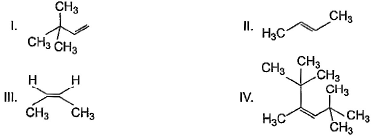CPU - 1 - Alkanes And Cycloalkanes I - Class 11 MCQ
22 Questions MCQ Test - CPU - 1 - Alkanes And Cycloalkanes I
Direction (Q. Nos. 1 - 12) This section contains 12 multiple choice questions. Each question has four choices (a), (b), (c) and (d), out of which ONLY ONE option is correct.
An alkane C6H14(X) can be obtained by reduction of five different alkyi halides C6H13CI (only structural isomers) with Zn-CH3COOH. The lUPAC name of X satisfying above condition is
Which of the following cannot be formed as single major product by Wurtz's coupling reaction of an alkyl halide?
| 1 Crore+ students have signed up on EduRev. Have you? Download the App |
Arrange the following compounds in increasing order of heat evolved when one mole of each of them is hydrogenated using Pt-catalyst.

In which of the following reaction, the Kolbe’s electrolysis product is incorrectly mentioned?
An alkane (X) with its molecular formula C6H14 can be obtained by reduction of only two isomeric alkyl chlorides (excluding stereoisomers) C6H13CI with Zn/acid. The alkyl chlorides are
A chiral hydrocarbon A (C5H8)o n catalytic hydrogenation is rendered achiral. Hence, A could be
The compound given below is chiral. What would be the outcome of catalytic hydrogenation of a pure enantiomer of this compound?
Which of the following upon catalytic hydrogenation produces racemic mixture.
The reagent used for catalytic hydrogenation of an alkene as well as bring about homogeneous catalysis is
Which of the following carboxylic acid can undergo decarboxylation on simple heating even in the absence of soda lime?
Which is least reactive alkyl halide in Wurtz coupling reaction?
What is the product in the following reaction?
Direction (Q. Nos. 13 - 16) This section contains 4 multiple choice questions. Each question has four choices (a), (b), (c) and (d), out of which ONE or MORE THAN ONE are correct.
Q. Which of the following cannot be obtained as single major product in the Wurtz’s coupling reaction of halides with sodium metal?
Which of the following decarboxylation reaction and their product is/are incorrectly matched?
Which of the following reduction reaction and their product is/are correctly matched?
What product(s) is/are expected in the electrolysis of aqueous solution of potassium propanoate?
Direction (Q. Nos. 17-19) This section contains a paragraph, describing theory, experiments, data, etc.
Three questions related to the paragraph have been given. Each question has only one correct answer among the four given options (a), (b), (c) and (d).
Passage
A hydrocarbon P has molecular formula C8H16 and it does not undergo hydrogenation with Raney Ni. A on free radical chlorination yields three monochloro derivatives Q,R and S (all structural isomers) with their molecular formula C8H15CI. Only Q can show optical isomerism. R on further chlorination produces a dichloride C8H14CI2 as one of the several isomers which on heating with sodium metal in etheral solution gives bicyclo [2, 2, 2] octane.
Q. Which of the following satisfy the criteria for P ?
Passage
A hydrocarbon P has molecular formula C8H16 and it does not undergo hydrogenation with Raney Ni. A on free radical chlorination yields three monochloro derivatives Q,R and S (all structural isomers) with their molecular formula C8H15CI. Only Q can show optical isomerism. R on further chlorination produces a dichloride C8H14CI2 as one of the several isomers which on heating with sodium metal in etheral solution gives bicyclo [2, 2, 2] octane.
Q. How many stereoisomers are possible for Q ?
Passage
A hydrocarbon P has molecular formula C8H16 and it does not undergo hydrogenation with Raney Ni. A on free radical chlorination yields three monochloro derivatives Q,R and S (all structural isomers) with their molecular formula C8H15CI. Only Q can show optical isomerism. R on further chlorination produces a dichloride C8H14CI2 as one of the several isomers which on heating with sodium metal in etheral solution gives bicyclo [2, 2, 2] octane.
Q. If S is dichlorinated, how many isomers would be produced? (exclude stereoisomers).
Direction (Q. Nos. 20 - 22) This section contains 3 questions. When worked out will result in an integer from 0 to 9 (both inclusive).
Q. How many different dichlorides, including stereoisomers by Wurtz coupling reaction with etheral solution of sodium, can give 1,4-dimethyl cyclohexane?
How many different alkenes with molar mass 84 upon hydrogenation can give 3-methyl pentane?
How many different halides with molecular formula C7H15CI upon reduction with (C6H5)3SnH can give 2,4-dimethyl pentane?

















